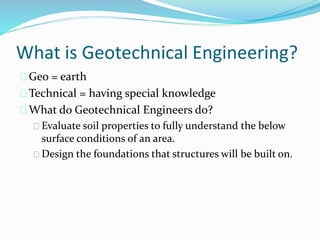The Single Strategy To Use For Geotheta
The Single Strategy To Use For Geotheta
Blog Article
Some Of Geotheta
Table of ContentsGeotheta Can Be Fun For AnyoneThe Best Strategy To Use For GeothetaNot known Factual Statements About Geotheta Geotheta - QuestionsThe Best Guide To Geotheta

They conduct site examinations, collect examples, perform laboratory tests, and examine information to assess the suitability of the ground for building and construction tasks - Engineer of Record. Based on their findings, geotechnical engineers offer suggestions for foundation design, incline security, preserving frameworks, and reduction of geotechnical threats. They team up with various other specialists, such as architects, architectural designers, and building teams, to guarantee that geotechnical considerations are integrated right into the overall task layout and application
By assessing the actions and buildings of dirt and rock, they can determine prospective geotechnical hazards such as landslides, soil negotiation, or slope instability. Their experience aids stop failures or crashes that could endanger lives and residential or commercial property. Below are some thorough tasks and obligations of a geotechnical engineer: Site Investigation: Geotechnical designers conduct site investigations to gather information on subsurface conditions.
They translate the information to understand the residential properties and actions of the dirt and rock, including their stamina, permeability, compaction characteristics, and groundwater problems. Geotechnical Evaluation and Layout: Geotechnical engineers analyze the data collected throughout site investigations to evaluate the stability and viability of the site for building projects. They perform geotechnical calculations and modeling to review aspects such as bearing ability, settlement, incline security, side earth pressures, and groundwater circulation.
Not known Details About Geotheta
Foundation Layout: Geotechnical engineers play an important function in designing foundations that can safely sustain the intended structure. They examine the soil conditions and load demands to identify the ideal structure kind, such as shallow structures (e.g., footings), deep structures (e.g (https://www.find-us-here.com/businesses/Geotheta-Alexandria-Alabama-USA/34113488/)., piles), or specialized strategies like soil enhancement. They think about elements such as negotiation restrictions, bearing ability, and soil-structure communication to create ideal structure designs
They assess construction plans, monitor website tasks, and perform area inspections to validate that the design referrals are adhered to. If unforeseen geotechnical issues emerge, they evaluate the circumstance and supply recommendations for removal or adjustments to the layout. Risk Assessment and Mitigation: Geotechnical engineers evaluate geotechnical threats and dangers connected with the task site, such as landslides, liquefaction, or soil disintegration.

Cooperation and Interaction: Geotechnical engineers work very closely with other specialists entailed in a task, such as architects, architectural designers, and construction teams. Effective interaction and partnership are important to incorporate geotechnical factors to consider into the overall project design and building process. Geotechnical designers offer technical know-how, response inquiries, and guarantee that geotechnical requirements are satisfied.
Excitement About Geotheta
Right here are some kinds of geotechnical engineers: Foundation Designer: Structure engineers specialize in making and analyzing structures for frameworks. They examine the dirt problems, load needs, and site attributes to determine one of the most proper structure kind and style, such as shallow structures, deep structures, or specialized techniques like pile foundations.
They examine the variables influencing incline security, such as dirt residential properties, groundwater conditions, and slope geometry, and establish strategies to avoid slope failures and minimize risks. Earthquake Designer: Quake engineers concentrate on examining and designing structures to withstand seismic pressures. They analyze the seismic threat of a website, review dirt liquefaction capacity, and develop seismic style standards to make sure the security and strength of frameworks during earthquakes.
They perform area testing, gather examples, and analyze the gathered information to define the soil properties, geologic formations, and groundwater conditions at a website. Geotechnical Instrumentation Engineer: Geotechnical instrumentation engineers concentrate on tracking and measuring the behavior of dirt, rock, and structures. They set up and preserve instrumentation systems that keep an eye on factors such as soil negotiation, groundwater degrees, slope motions, and structural variations to analyze performance and give very early warnings of possible issues.
Little Known Facts About Geotheta.
They perform tests such as triaxial examinations, combination examinations, direct shear tests, and leaks in the structure examinations to collect information for geotechnical analysis and layout. Geosynthetics Designer: Geosynthetics designers concentrate on the design and application of geosynthetic materials, such as geotextiles, geogrids, and geomembranes. They utilize these products to boost dirt security, reinforce inclines, supply water drainage services, and control erosion.
They have a tendency to be investigatory individuals, which indicates they're intellectual, reflective, and analytical. They wonder, systematic, sensible, logical, and logical. A few of them are also social, implying they're kind, charitable, participating, person, caring, useful, compassionate, skillful, and friendly. Does this noise like you? Take our complimentary occupation examination to discover if geotechnical engineer is one of your top career matches.
In the workplace setting, geotechnical designers use specialized software devices to do calculations, produce designs, and analyze information. They prepare reports, evaluation job specs, connect with customers and staff member, and coordinate task activities. The workplace setting provides a helpful atmosphere for research, evaluation, and partnership with various other experts associated with the task.
Geotheta Can Be Fun For Anyone
They often go to task sites to conduct site examinations, evaluate geotechnical conditions, and collect information for analysis. These visits include traveling to various areas, in some cases in remote or challenging surfaces. Geotechnical designers may execute soil tasting, conduct tests, and display building and construction activities to make sure that the geotechnical aspects of the job are being applied correctly.
Geotechnical designers likewise operate in specialized geotechnical labs. In these centers, they perform experiments, carry out examinations on dirt and rock examples, and assess the design properties of the products. Geotechnical research laboratory engineers function thoroughly in these settings, handling screening devices, operating tools, and recording data. They team up with other lab personnel to ensure exact and dependable testing outcomes.
Report this page